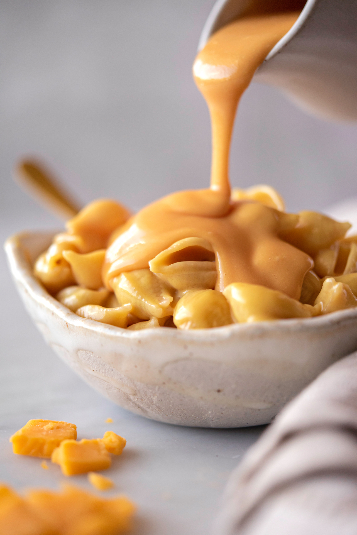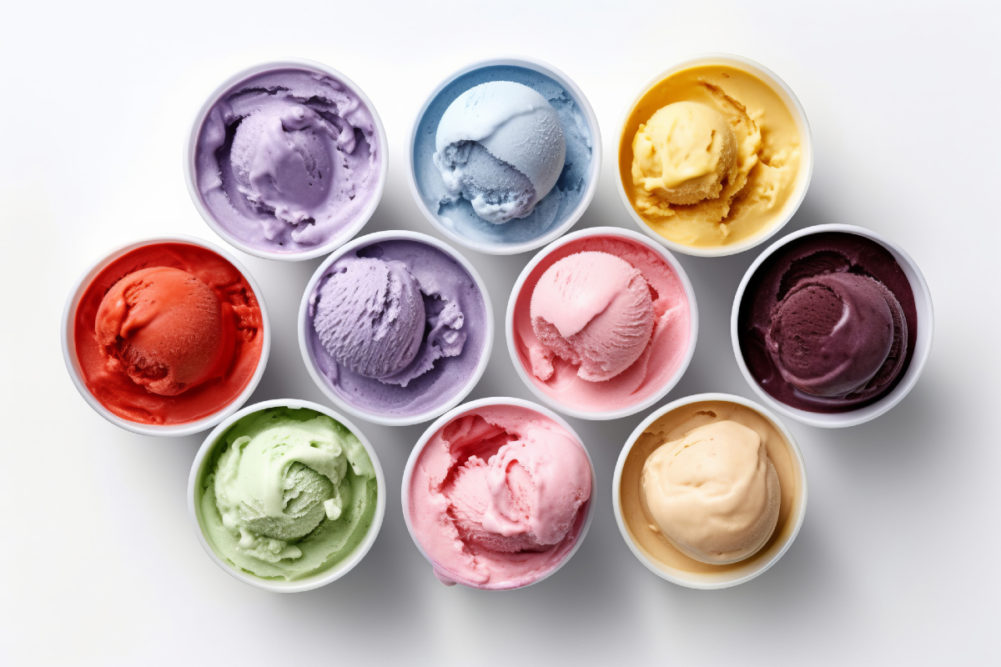Consumers expect strawberry yogurt to have a reddish hue and chocolate milk to be a creamy brown. They want butter to be pale yellow and, depending upon where they live in the United States, cheddar cheese should be either orange or white.
Food colors may assist.
The role of colors
Shade of color impacts perception. A bright red strawberry yogurt drink suggests it is sweet, maybe like strawberry flavored candy, while one would expect a muted red color to have a more farm fresh profile. A deep purple-like blue may represent blueberry, whereas a more pastel hue suggests cotton candy.
Food colors allow for batch to batch consistency and can help compensate for inconsistent ingredient or base colors, which with fluid milk is a seasonal and regional challenge. Color may also be used to convey premium ingredients or nutritional positioning. But possibly the most important role of color is to trigger flavor expectation.
“Before tasting a food product, our eyes set the stage, creating a sensory anticipation that extends beyond the immediate consumption experience,” said Erika Tchang, head of sales and marketing-US, Sethness Roquette, Skokie, Ill. “The right hues and color combinations tap into taste expectations and evoke associations that enhance the overall enjoyment of dairy products.”
Colors should complement the flavor, unless the product is intended to be a surprise. Lemon yogurt cannot be pink and vanilla ice cream should not be blue. Color plays a pivotal role in shaping taste expectations. A dark-colored chocolate devil’s food cake inclusion in ice cream or yogurt suggests indulgence. But if it’s a washed-out tan color, the decadence aura fades away.
Sensient Food Colors, St. Louis, Mo., conducted in-person and online consumer testing to assess the quantitative impact of color on purchase intent, flavor perception and consumer product liking. The results confirm that color matters.
“Our consumer research shows that optimized color can improve flavor perception,” said Meghan Skidmore, content marketing manager at Sensient. “Optimized means that the color aligns with the flavor profile advertised. For example, a colorless/white yogurt drink that claimed to have a strawberry flavor looked less flavorful, less sweet and less appealing to consumers than a pink yogurt drink. Developers who don’t optimize for color are leaving flavor opportunity on the table.”
Alice Lee, technical marketing manager, GNT USA, LLC, Dallas, NC, said, “There are also opportunities to play with flavor expectations, especially in products targeted at kids. Blue raspberry is a great example because it is now a staple in many products despite the disparity between color and flavor. Unexpected colors can create a sense of fun and excitement in limited edition launches, in particular.”
Understanding options
The US Food and Drug Administration (FDA) regulates edible colorants and classifies them as either “certified colors,” also known as artificial colors, or “colors exempt from certification,” which by default has come to mean natural colors. Certified colors are identified with the prefix FD&C, which indicates they are certified for use in foods, drugs and cosmetics. These synthetic colors are made from petroleum and are valued for their consistency, stability and low cost.
The FDA does not define natural colors and many have come under scrutiny in recent years. That’s because not all natural colors are created equal. US food and beverage marketers have taken it upon themselves to communicate the difference, something that European Union regulations require.
In the EU there are two separate categories of so-called natural colors: non-artificial additive colors and coloring foods. The former requires an E number and is defined as pigment extracted from natural or nature-identical sources.
“Colors do not always meet with consumer expectations around naturality,” Lee said. “Carmine, for example, is considered a natural color but is produced from the inedible cochineal insect.
“The category of ‘coloring foods,’ on the other hand, must be created from edible fruits, vegetables or plants and processed using only water and physical methods, such as chopping and pressing,” she said. “They are actually food concentrates that can be eaten by the spoonful. In the EU and various countries worldwide, coloring foods are labeled as food ingredients, such as ‘carrot and beetroot concentrate,’ with no E numbers required.”
In the US, it is common to see such ingredients labeled as “fruit & vegetable juice (color),” “turmeric (color)” and “spirulina extract (color).” Color hues of these plant-derived ingredients may be sensitive to temperature and pH, changing the end result of the intended color.
“Black carrot concentrates contain anthocyanin pigments that can be influenced by the pH value of the application,” Lee said. “Beetroot concentrates, on the other hand, are pH-independent but sensitive to heat. We offer a vast range of colors made from more than 30 different raw materials and in different product formats. We work hard to increase the color content of the crops using natural methods, as well, allowing us to grow fewer crops to achieve the same results.”
The botanical sources used to produce colors are different from the products sold in the grocery store. These plants have been bred and optimized to maximize color output.
“On the developer side, this is great news,” Skidmore said “Increased color concentration results in less color needed for the same performance, which means lower cost-in-use. On the food chain side, the fruits and vegetables being processed for color would never enter the human consumption cycle on their own. It’s an entirely different type of botanical.
“Even within a specific botanical type, like beet, there can be different color tones or shades, different betanin levels, different concentrations in application, different stability under heat and different flavor off-note impacts,” Skidmore said. “It’s important for developers to understand the benefits or disadvantages of a specific color solution before implementing it in application. Sometimes a better beet (or carrot or radish) is just around the corner, and sometimes there’s an even better botanical natural color option waiting for you.”
Navigating neutrals
In the world of food color, blacks, browns and whites are strange. There are no approved certified options in the US. And at the same time, these colors are not associated with any plants.
Formulators looking to add black or brown hues have typically relied on caramel colors. These are produced through the controlled heat treatment or cooking of carbohydrates, a process known as caramelization.
“Caramel color is stable, like an FD&C color, but with a more consumer-friendly label,” Tchang said. “Because of their stability, caramel colors are extremely cost efficient when reviewing cost impact over the course of the finished product.”
Caramel colors come in various shades, everything from light yellow to dark brown. They are available in liquid and powdered formats.
The color “white” is one of the most complex in the world of food colorants. Titanium dioxide has long been a formulator’s go-to bright white and opacity ingredient. In the US, the FDA recognizes it as a GRAS (generally recognized as safe) ingredient at levels of no more than 1% of the food by weight. It is also exempt from certification, which suggests it’s a natural color. It’s been in and out of the human safety conversation since the European Food Safety Authority banned its use as a food additive in the EU in 2021. California was considering banning the sale and manufacture of foods containing titanium dioxide this past year.
Titanium dioxide is made from titanium, which is classified as a transition metal on the periodic table and interacts with oxygen to form titanium oxides.
 Photo: GNT USA
Photo: GNT USAIn the US, titanium dioxide may not be used in foods with a standard of identity unless it is included in the standard. The standard for mozzarella cheese, for example, states that coloring may be used to mask any natural yellow color in the curd. Monterey Jack cheese, on the other hand, does not have color included in its standard of identity. So while it is a white cheese, color cannot be added to make it whiter, as can be done with mozzarella. For non-standardized products, titanium dioxide is an easy way to correct off colors.
“Dairy products tend to be white; consumers associate the color with purity, natural and clean,” said Cuie Yan, vice president of microencapsulation, Blue California, Rancho Santa Margarita, Calif. “Brands that seek to replace the titanium dioxide white colorant will find many benefits to our patent-pending food-grade whitening agents. The whiteness increases as the dosage increases.
“We’re noticing the best applications are in sugar-reduced drinks, such as coffee creamers, plant-based protein drinks, baby foods, etc.,” Yan said. “The textural quality of our titanium dioxide alternatives enhances mouthfeel while whitening.”
ADM developed an alternative to titanium dioxide using raw materials derived from natural sources, including native corn starch. It is offered in powdered and liquid emulsion forms.
“We use our powdered solutions in yogurt and frozen treats, while our liquid emulsions work well in dairy-based beverage applications to mitigate ringing, precipitation sediments and staining,” said Emina Goodman, senior director-colors, ADM, Chicago. “In addition, our white solutions work well with other hues from our larger colors portfolio. They combine to produce beautiful pastels and lighter shades, unlocking a wide range of naturally derived color opportunities.”
New blue gets approved
The FDA amended the list of color additives exempt from certification in late 2023 to provide for the safe use of jagua blue. This color is derived from the pulp of the unripe jagua fruit (Genipa americana), also known as huito. Applications approved for use include flavored milk, dairy drinks and substitutes, dairy and dairy alternative yogurt, ice cream, frozen dairy and dairy alternative desserts, puddings, gelatins, ices, sorbets, non-alcoholic fruit based/flavored drinks, nutritional beverages and smoothies, flavored cream cheese-based spreads and icings, frostings, jams, syrups, and fruit toppings and fillings.
Jagua blue offers a safe and vibrant, naturally sourced blue color that can be blended with other natural colors to create vivid and stable green, purple and brown shades. This is the first acid-stable natural blue to be approved and is the only jagua blue that has been reviewed and deemed safe by FDA.
“Given its high color concentration and its robustness towards heat, light and acidity, jagua blue is an easy-to-use, cost-effective natural blue,” said Luc Ganivet, chief innovation officer, Oterra, Denmark. “It means manufacturers can now create natural shades of green and purple that were previously impossible to achieve without using artificial colors.”

